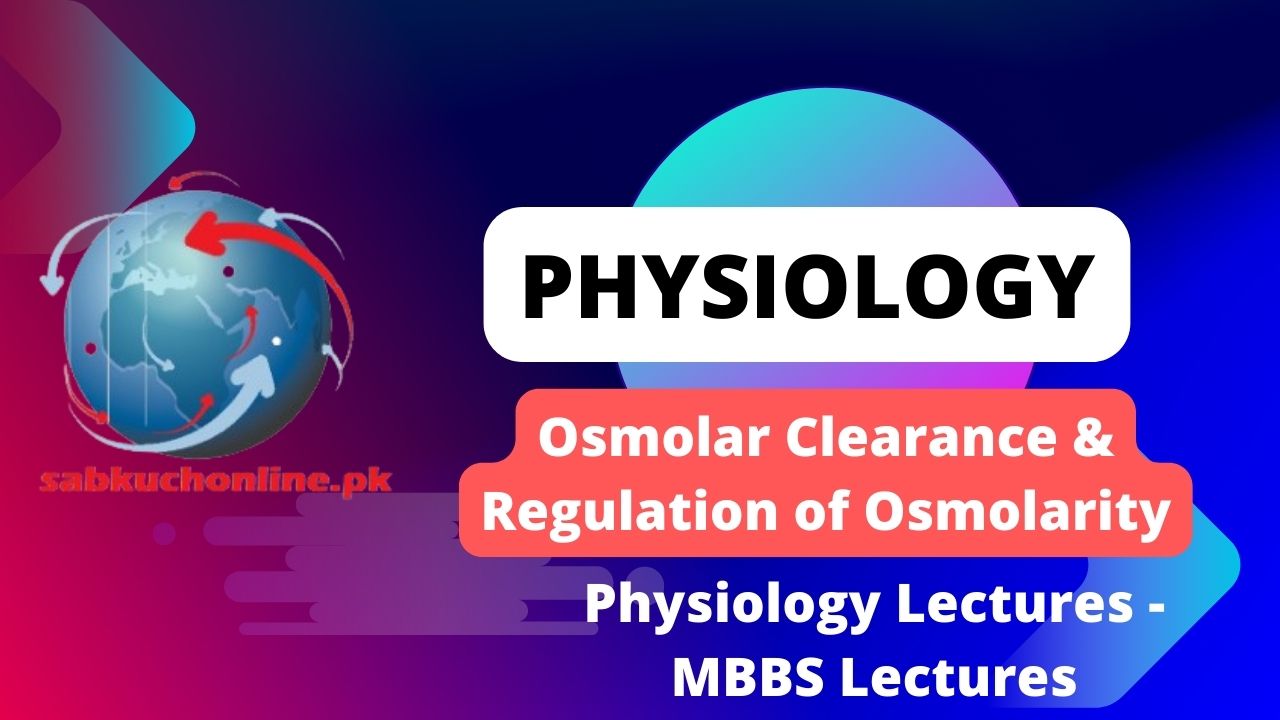ECF Osmolarity
•Osmolarity= solutes concentration/ volume of ECF
•Normal value= 300mOsml/L
•Closely linked with sodium concentration
•Plasma sodium concentration is 140-145mEq/L
•Osmolarity of ECF depends upon
–Intake —thirst
–Output —Renal excretion of water—–GF, tubular reabsorption
•Plasma osmolarityis not measured exactly
•Estimated by plasma sodium concentration
•Posm= 2.1X plasma sodium concentration
= 2.1 X 142 = 298m Osm/L
•In renal disease glucose and urea are also considered
Posm=2X(PNa+)+(PGlucose)+(PUrea)
•Contribution to extracellular osmoles
–By Na–94%
–By urea and glucose–3-5%
Urine Osmolarity
•Ranges between 500-800 mOsm/L
•Capacity to dilute or concentrate urine 50-1400 mOsm/L
•Regulate water excretion independent of solute excretion
•Without major changes in excretion of solutes (Na, K)
ECF Osmolarity
•Primary mechanisms involved
–Osmoreceptor-ADH system
–Thirst mechanism
•Osmoreceptor-ADH system
–Reabsorbs water from kidney
–Stimulate thirst
Osmoreceptors
•Special nerve cells
•Anterior hypothalamus near the supraopticnuclei
•Shrinkage of the osmoreceptorcells causes them to fire
•Induce thirst in response to increased extracellular fluid osmolarity

ADH
•Rapid response
•5/6thby supra optic and 1/6thby paraventricular nuclei
•Nuclei have axonal extension extending to post pituitary
•Stored in secretory granules (or vesicles) in the nerve endings
•Released by calcium entry
•Released from post pituitary by increased plasma osmolarity
•Increases the water permeability from kidney
AV3V
•Anteroventral region of the third ventricle, called the AV3V region.
•At the upper part of this region is subfornical organ & at the inferior part is organum vasculosum of lamina terminalis
•Does not have blood brain barrier
•Sense the changes immediately even with a small change in osmolarity

Osmoreceptor-ADH feedback
1.Shrinkage of osmoreceptors
2.Signals to supraoptic nucleus
3.Stimulate pituitary gland(post)
4.Release ADH
5.Reaches kidney insert aquaporins on luminal surface of DCT and CT
6.Increases water transport
7.Concentrated urine

ADH
•ADH release is controlled
- Cardiovascular reflexes (high pressure areas)
–Baroreceptor reflex
–Cardiopulmonary reflex - Reflexes originate in low pressure areas
- Increased osmolarity
- Blood pressure
- Blood volume
•Hemorrhage —blood volume —ADH release —water reabsorption —blood volume restored


Thirst Mechanism
•Thirst centrein hypothalamus
–Stimulated/inhibited by osmoreceptors
–Functions in union with ADH system
–Restores changes in ECF osmolarity
•Same AV3V region stimulates thirst
•Another area near preoptic nucleus—thirst center


Role of Angiotensin & Aldosterone
•Sodium reabsorption(under extreme conditions)
–Angiotensin
–Aldosterone
•Also drag water along
•Hyperaldosteronism
–Only 3-5mEq/L rise due to subsequent absorption of water
•Addison’s Disease

•Almost no change
1.Sodium absorbed along with water
2.Thirst mechanism intake of water is increased towards increased sodium concentration

Salt Appetite Mechanism
•Salt craving due to deficiency of Na+
•Na + deficiency generally doesn’t happen
–We ingest salt more than is required
•Regulated by renin angiotensin aldosterone system (system controlling ECF/blood volume/arterial pressure)





Osmotic Imbalances
•Hyperosmotic overhydration
–Conn’s syndrome
•aldosterone (primary aldosteronism)
•Na+ retention
•water retention (not proportionate)
•Hypo-osmotic overhydration
–Syndrome of inappropriate secretion of ADH
•retention of water
•Hypo-osmotic dehydration
–Addison’s disease
•aldosterone
•Na+ loss
•water loss (not proportionate)
•Hyperosmotic dehydration
–Insufficient water intake
–Excessive water loss (sweating)
–Diabetes insipidus
